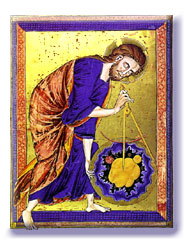 WEMSK6:
Geometry
WEMSK6:
Geometry
This week's WEMSK is supposed to be on geometry in the Middle Ages.
Actually, it is easy, since anyone can find a Euclid, and that is
what they used for the most part. I thought I would follow a
suggestion from a lurker, who wanted to learn by the royal road.
I. If you know nothing about mathematics, a good book to page
through is Lancelot Hogben, _Mathematics for the Million_ (London:
Allen & Unwin). Unfortunately, I own only my old German edition,
_Mathematik fuer Alle_, tr. Waldemar Bodmer (Cologne: Kiepenheuer
& Witsch, 1953).
2. For learning the math behind computers: John G. Kemeny (he
invented BASIC) et al., _Introduction to Finite Mathematics_, 2d
ed. (Englewood Cliffs, NJ: Prentice-Hall, 1966). Do the parts
on
truth tables, and you will have learned a lot about wiring and the
organization of the computer. You can also impress your computer-
jock friends by telling what a nor-gate really is and drawing them
a truth table. If you can still find one, there is a great game,
named WFF-n Proof. My kids learned to read the Journal of Symbolic
Logic and do the proofs from this, which teaches you Polish
notation, more cocktail party fare. This number is a TAN.
3. There are other good books one level up from Hogben: George
Polya, _How to Solve It_, 2d ed. (Garden City, NY: Doubleday Anchor
Books, 1957. George Polya, _Mathematical Discovery_, 2 vols. (NY:
John Wiley and Sons, 1962-65). Both delightful and not hard to
read; don't let them buffalo you. Another sort of elementary
book,
but forbidding: Evert W. Beth, _The Foundations of Mathematics_,
rev. ed. Harper Torchbooks, TB 581 X (NY: Harper & Row, 1964).
Again, these are just for reading through and getting a feeling for
how mathematicians work.
4. For looking at the mathematicians themselves, there are good
reading books:
a. The Treasury of Mathematics, ed. Henrietta O. Midonick (NY:
Philosophical Library, 1965). If you see this in some used
bookstore, pick it up. Lots of historical sources.
b. A grand set of books, usually boxed and available in paperback:
_The World of Mathematics_, ed. James R. Newman, 4 vols. (NY: Simon
& Schuster, 1956). This is great just to have around the
house and
page through. More cocktail party fare: "Have you heard of the
cocktail-party problem?" "They say that the four color problem has
been solved, but you cannot solve a math problem by iteration."
"Did you know that Goethe tried to solve the Seven Bridges to
Koenigsberg?"
c. Another good source book is David Eugene Smith, _A Source Book
in Mathematics_, 2 vols. (NY: Dover, 1959; repr. of a 1929 book).
It is probably still available, but it leans too much to the
present to be of much use to us.
d. Somewhat more forbidding and less historical: _Mathematics. Its
Content, Methods, and Meaning_, ed. A. D. Aleksandrov, A. N.
Kolmogorov, M. A. Lavrent'ev; transl. by S. H.Gould and T. Bartha,
3 vols. (Cambridge, MA: M.I.T Press, 1963). As a medievalist
you
may as well forget about this one, but it comes nicely boxed and it
can help.
5. For the history of mathematics:
a. David Eugene Smith, _History of Mathematics_, 2 vols. (Boston:
Ginn & Co., 1923-25). Your best first port of call. Well
written,
though it passes through our period rather rapidly. It has also
been reprinted by Dover; make sure and read the 2nd vol. also.
b. Moritz Cantor, Vorlesungen ueber Geschichte der Mathematik, 2d
ed., 4 vols. (Leipzig: Teubner, 1894-1908). The volumes which
interest us most are the first and second. Also available in
microcard (micro-opaque) (NY: Readex Microprint, 1968.
6. For the history of medieval geometry itself:
a. Wilbur Richard Knorr, Textual studies in ancient and medieval
geometry (Boston: Birkhauser, 1989). Fairly up to date, about 15
pages of bibliography. Look here first for geometry.
b. Archimedes in the Middle Ages, ed. Marshall Clagett. 4 vols.
Memoirs of the American Philosophical Society, 117, 125, 137
(Madison: University of Wisconsin Press, 1964-80). Vol. one not
in
Memoirs. Readable and thorough. We have a later section
on
mechanics and engineering, but this really belongs here.
c. Cornelius Lanczos, Space through the ages: The evolution of
geometrical ideas from Pythagoras to Hilbert and Einstein. (NY:
Academic Press, 1970). Just for paging through.
7. If you want to read some of the texts, first read Euclid, then
you can branch out:
a. Medieval Mensuration: Quadrans vetus and Geometrie due sunt
partes principales, ed. Nan L. Hahn. TAPS 72.8 (Philadelphia:
American Philosophical Society, 1982). Robertus anglicus and
Johannes anglicus, both of the 13th.
b. Lynn Thorndike, The Sphere of Sacrobosco and its commentators.
Corpus of Mediaeval Scientific Texts 2 (Chicago: UChicagoP, 1949).
An easy read and worthwhile.
c. Nicole Oresme and the Medieval Geometry of Qualities and
Motions; a treatise on the uniformity and difformity of intensities
known as Tractatus de configurationibus qualitatum et motuum, ed.
with an introd., English transl., and commentary by Marshall
Clagett (Madison: University of Wisconsin Press, 1968).
You can't
beat Clagett. Latin with facing English.